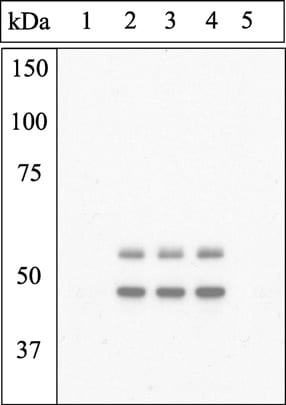Anti-GSK3 (alpha + beta) (phospho Y216 + Y279) antibody (ab4797)
Key features and details
- Rabbit polyclonal to GSK3 (alpha + beta) (phospho Y216 + Y279)
- Suitable for: WB
- Reacts with: Mouse
- Isotype: IgG
Overview
-
Product name
Anti-GSK3 (alpha + beta) (phospho Y216 + Y279) antibody
See all GSK3 (alpha + beta) primary antibodies -
Description
Rabbit polyclonal to GSK3 (alpha + beta) (phospho Y216 + Y279) -
Host species
Rabbit -
Tested Applications & Species
See all applications and species dataApplication Species WB Mouse -
Immunogen
Synthetic peptide derived from the regions of GSK 3 alpha + beta protein that contain tyrosine 216/279.
-
General notes
Glycogen synthase kinase-3 (GSK 3) is a proline-directed serine-threonine kinase that was initially identified as a phosphorylating and inactivating glycogen synthase. Two isoforms, alpha (GSK 3A) and beta, show a high degree of amino acid homology. GSK 3B is involved in energy metabolism, neuronal cell development, and body pattern formation.
Properties
-
Form
Liquid -
Storage instructions
Shipped at 4°C. Upon delivery aliquot and store at -20°C or -80°C. Avoid repeated freeze / thaw cycles. -
Storage buffer
pH: 7.3
Constituent: PBS -
 Concentration information loading...
Concentration information loading... -
Purity
Immunogen affinity purified -
Purification notes
Purified from rabbit serum by epitope specific affinity chromatography. Any reactivity towards the non-tyrosine phosphorylated GSK 3 alpha + beta protein has been eliminated through a series of preabsorption steps. -
Primary antibody notes
Glycogen synthase kinase-3 (GSK 3) is a proline-directed serine-threonine kinase that was initially identified as a phosphorylating and inactivating glycogen synthase. Two isoforms, alpha (GSK 3A) and beta, show a high degree of amino acid homology. GSK 3B is involved in energy metabolism, neuronal cell development, and body pattern formation. -
Clonality
Polyclonal -
Isotype
IgG -
Research areas
Images
-
Extracts of 3T3L1 cells stimulated with 100 nM insulin for 10 minutes were resolved by SDS-PAGE on a 10% Tris-glycine gel and transferred to PVDF. The membrane was blocked with a 5% BSA-TBST buffer for one hour at room temperature and either left untreated (1-4) or treated with lambda (λ) phosphatase (5), then incubated with the GSK-3 α [pY279] / β [pY216] antibody for two hours at room temperature in a 1% BSATBST buffer, following its prior incubation with: the phosphopeptide immunogen (1), no peptide (2), the non-hosphopeptide corresponding to the phosphopeptide immunogen (3), or a generic phosphotyrosine-containing peptide (4). After washing, the membrane was incubated with goat F(ab’) 2 anti-rabbit IgG HRP conjugate, and signals were detected. The data show that only the phosphopeptide corresponding to GSK-3α [pY279] /β[pY216] blocks the antibody signal, demonstrating the specificity of the antibody. The data also show that phosphatase stripping eliminates the signal, further verifying that the antibody is phospho-specific.








